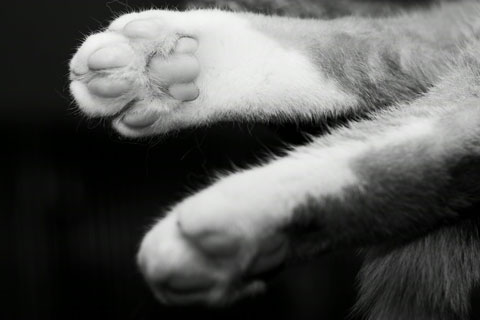Dear Dr. Main,
My dog has seemed itchy lately and is licking his feet a lot. What should I do?
Itching for an Answer
Dear Itching for an Answer:
There are a number of conditions that can lead to itching and licking in dogs. The most common is called atopy or atopic dermatitis. This is a condition that is thought to be related to allergies to inhaled substances. These substances, called allergens, may be pollens, plant or animal fibers, house dust, or molds. Animals with atopic dermatitis often show symptoms such as scratching, especially at their ears and axillae, licking their feet and rubbing their face.
Atopic dermatitis is most commonly seen this time of year simply because there is much more pollen, grasses, and trees contributing to the problem. Atopic dermatitis is not the only condition that can cause itching and licking in your pet. One must consider other allergic conditions such as: flea bite allergy, food allergy, drug allergy and contact allergy. In addition, some infectious diseases can lead to itching such as Sarcoptic mange, Malassezia (yeast) colonization of the skin, and bacterial (staphylococcal) infection of the skin. Most of these conditions other than atopy can be diagnosed by a veterinary exam that might include various scrapings or collection of samples from the skin for microscopic evaluation. In fact when all these simple tests are negative one is left with the diagnosis of atopy. The diagnosis of atopy can be confirmed by intradermal skin testing or blood testing, however these tests are usually reserved for the more chronic and difficult cases.
If a pet is diagnosed with atopy there are several therapies available. In general, it is important to act quickly when your pet is itching. Often the pet's itching can intensify quickly and severe sores can develop on the skin. Therefore early intervention is advised. As for therapies, the first would be to attempt to remove the offending allergen from the environment if possible. You may want to consider an air purifier to remove pollens. Next hyposensitization can be attempted with an approximate 60 percent success rate after 10 months of "allergy shots."
The third therapy and the most common is the use of anti-allergy drugs. Unfortunately antihistamines are of limited use in small animals, but can always be tried. An example might be Benadryl or Chlorpheneramine as well as many others. Ultimately the careful use of coticosteroids is the most effective therapy for allergies. Cortisone quiets down the body's response to the allergens on a cellular level.
There is no cure for atopy, only management. Pets with this condition tend to have recurrences at specific times of the year related to their problematic allergens. Successful management involves early intervention, careful observation of your pet and figuring out which medication works best and the lowest dose that is helpful. Controlling itching and atopy early will prevent severe skin lesions from developing and also limit secondary problems like bacterial infection of the skin and ear infections.
All in all, atopy can be frustrating for the pet, the owner, and the veterinarian. Yet with careful observation and good communication between all, most pets? symptoms can be managed very well.




 WSHS can accept credit-card donations online using a secure server. Click on the Donate Now button. You can choose how your donation will be used! All donations are tax deductible.
WSHS can accept credit-card donations online using a secure server. Click on the Donate Now button. You can choose how your donation will be used! All donations are tax deductible.